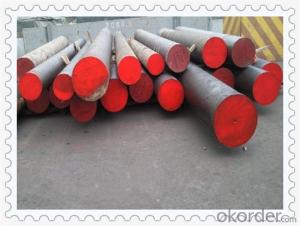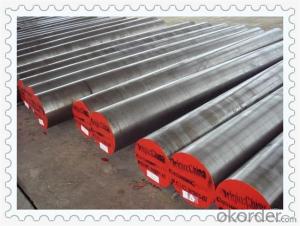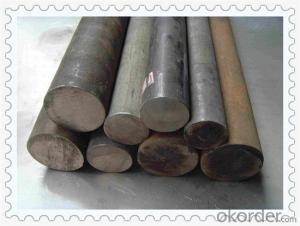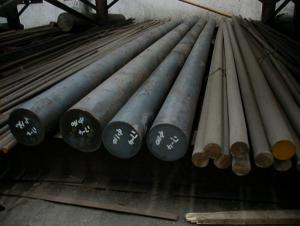Hot Rolled Alloy Carbon Structural Steel Bars
- Loading Port:
- China main port
- Payment Terms:
- TT OR LC
- Min Order Qty:
- 30 m.t.
- Supply Capability:
- 10000 m.t./month
OKorder Service Pledge
OKorder Financial Service
You Might Also Like
Hot Rolled Alloy Carbon Structural Steel Bars
Products Details
Product Name | Alloy Steel 1.2379 |
Standard | ASTM A689, JIS G4801, DIN 17221, GB/T 18254, ASTM A295, JIS G4805, etc. |
Spring steel | 65Mn, 1566, 60Si2Mn, 9260, etc. |
Bearing steel | GCr15, SAE52100, GCr15SiMn, 100CrMnSi6-4, SJU2, etc. |
Cold heading steel | ML25, ML35, etc. |
Alloy structural steel | 40CrNiMo, SAE4330, 42CrMo, 15Cr2Ni2, 40CrNi2Mo, 35CrMoV, 12Cr1MoV, ASTM4130, SCM420, 40CrV, etc. |
Military steel | 20Cr2Ni4A, 18Cr2Ni4WA, 23CrNiMo7-4-7, etc. |
Heat resistant steel | 5CrNiMoV, 4Cr10Si2Mo, etc. |
Mold and tool steel | SKD62, Cr12, 31CrMoV9, H11, 4Cr5MoSiV1, SKD61, DIN1.2344, H13, 35CrMoV, Cr12Mo1V1, SKD11, X153CrMoV12, D2, O1, DIN1.2510, P20, DIN1.2311, 3Cr2Mo, 9CrWMn, 4Cr13, AISI420, DIN1.2083, Cr12MoV, DIN1.2601, P20+Ni, Cr8Mo2SiV, DC53, DIN1.2738, etc. |
Gear steel | ASTM8620, SAE4340, SNCM430, 40CrNiMo, etc. |
Size | Round bar: 15-1200mm Square bar: 80-800mm |
Length | 2-12m, as customers' requirement. |
Melting process | EAF+LF+VD |
Ultrasonic testing | SEP1921-84 C/C, D/D, E/E |
Surface treatment | Black, grinded, peeled, polished are available |
Delivery condition | Annealing, tempering, quenching + tempering |
Technique | hot rolled, cold drawn, forged are available |
Package | Standard seaworthy packing, as customers’ requirement |
Delivery Time | 30 days after receipt of the deposit, negotiable. |
Available Sizes
Grade | Size (mm) | ||||
Round rolled steel (Dia.) | Flat rolled steel | Round forged steel (Dia.) | Square forged steel | Bright bar (Dia.) | |
High-quality carbon structural steel | 16-320 | 5-38 44-150 | 120-900 | 100-750 | 12-150 |
Alloy structural steel | 16-320 | 5-38 44-150 | 120-900 | 100-750 | 12-150 |
Carbon tool steel | 16-320 | 5-38 44-150 | 120-350 | 100-310 | 12-150 |
Alloy tool steel | 30-90 | 100-900 | 100-750 | 12-150 | |
High speed tool steel | 80-120 | 80-110 | 12-150 | ||
Bearing steel | 16-320 | 5-38 44-150 | 120-300 | 100-600 | 12-150 |
Spring steel | 14-180 | 5-38 44-150 | 120-300 | 100-260 | 12-150 |
Stainless steel | 16-250 | 120-750 | 120-600 | 12-150 | |
High temperature alloy steel | 55-200 | 80-200 | 12-150 | ||
Free-cutting steel | 14-250 | 120-400 | 12-150 | ||
Gear steel | 16-320 | 5-38 44-150 | 120-900 | 15-150 | |
Products Show

Product Overviews
| Product Name | Typical Grades | Diameter(mm) | Standard adopted |
| Carbon Steel | 20 (1020/S20C/C22) | Ø16-Ø300 |
GB/SAE/JIS/DIN
|
| 40 (1040/S40C/C40) | |||
| 45 (1045/S45C/C45) | |||
| Bearing Steel | GCr9 (51100/SUJ1) | Ø12-Ø250 | |
| GCr15 (52100/SUJ2/100Gr6) | |||
| GCr9SiMn (A485-Gr.1/SUJ3) | |||
Cr-Mo Steel | 20Cr (5120/SCr420H/20Cr4) | Ø12-Ø250 | |
| 40Cr (5140/SCr440/41Cr4) | |||
| 42CrMo(4140/SCM440/42CrMo4) | |||
| Gear Steel | 20CrNiMo | Ø16-Ø600 | |
| 20CrMn(5115/SMnC420/20MnCr5) | |||
| 20CrNiMo(8620/SNCM220/20CrMiMo2) |
Application
| Carbon Steel | Mold bottom, Plastic mold, Construction machinery parts Automobile parts, Security grills, Screens, Construction |
| Bearing Steel | Aerospace, Navigation, Nuclear energy, Chemical industry Electronic information, Petrochemical, Instrument and meter Transportation |
| Cr-Mo Steel | Mechanism & Fasteners gear, Stressed components for vehicles Engines and machines, Parts of larger cross-section |
| Gear Steel | All kinds of gears, Statically and dynamically stressed component for vehicles Engines and machine, Larger cross-section parts, Crankshafts |
Work Shop

Company Information
CNBM International Corporation is the most important trading platform of CNBM group.
Whith its advantages, CNBM International are mainly concentrate on Cement, Glass, Iron and Steel, Ceramics industries and devotes herself for supplying high qulity series of refractories as well as technical consultancies and logistics solutions.


FAQ
1, Your advantages?
professional products inquiry, products knowledge train (for agents), smooth goods delivery, excellent customer solution proposale
2, Test & Certificate?
SGS test is available, customer inspection before shipping is welcome, third party inspection is no problem
3, Factory or Trading Company?
CNBM is a trading company but we have so many protocol factories and CNBM works as a trading department of these factories. Also CNBM is the holding company of many factories.
4, Payment Terms?
30% TT as deposit and 70% before delivery.
Irrevocable L/C at sight.
5, Trading Terms?
EXW, FOB, CIF, FFR, CNF
6, After-sale Service?
CNBM provides the services and support you need for every step of our cooperation. We're the business partner you can trust.
For any problem, please kindly contact us at any your convenient time.
We'll reply you in our first priority within 24 hours.
Packaging & Delivery
1, Packaging: seaworthy package or as required
2, Delivery: 35-45 days or based on quantity

- Q:How do you determine the strength and hardness of a steel round bar?
- To determine the strength and hardness of a steel round bar, several tests and techniques can be employed. One of the most common methods is the tensile strength test. In this test, a sample of the steel round bar is subjected to a gradually increasing load until it reaches its breaking point. The maximum load it can withstand before breaking is recorded, which gives an indication of the bar's strength. Hardness testing is another crucial measure of steel round bar quality. The Rockwell hardness test is frequently used, where a diamond or tungsten carbide ball is pressed into the surface of the bar with a specific load. The depth of the indentation made by the ball is measured, and the hardness value is determined based on a standardized scale. Additionally, the Brinell hardness test can be utilized, where a hardened steel ball is pressed into the surface of the round bar with a specific load. The diameter of the indentation formed is measured, and the hardness is calculated based on the applied load and the size of the indentation. Furthermore, there are non-destructive techniques such as ultrasonic testing and magnetic particle inspection that can provide information about the internal structure, defects, and cracks within the steel round bar, thus indirectly indicating its strength and hardness. It is important to note that various factors, including the composition of the steel, its heat treatment, and the manufacturing process, can influence the strength and hardness of a round bar. Therefore, it is advisable to consult standards and specifications that define the expected properties for the specific type of steel round bar being tested.
- Q:Can steel round bars be used in the manufacturing of garden tools?
- Yes, steel round bars can be used in the manufacturing of garden tools. Steel is a durable and robust material that offers strength and resistance, making it suitable for various garden tools such as shovels, rakes, hoes, and spades. The round bars can be shaped and formed to create the desired tool design and functionality, ensuring durability and longevity in outdoor conditions.
- Q:Can steel bars be replaced by large screws in the concrete floor?
- In theory, how big a round steel will have to replace the large thread steel, and if it is cast, then still better to use thread steel, screw steel tensile resistance than round steel by strong
- Q:Can steel round bars be used in the production of telecommunications equipment?
- Indeed, the utilization of steel round bars in the manufacturing of telecommunications equipment is feasible. These bars, renowned for their robustness, resilience, and adaptability, find widespread employment across diverse industries, including telecommunications. They serve as a fundamental building material for fabricating structural elements, frameworks, supports, and mounting brackets crucial to the functionality of telecommunications equipment. Moreover, through machining and shaping, steel round bars can be tailored to meet the specific form requirements of various equipment applications. Furthermore, steel round bars possess the invaluable ability to provide essential electromagnetic shielding and grounding capabilities, indispensable for the proper operation of telecommunications equipment.
- Q:Can steel round bars be used for making oil and gas industry components?
- Yes, steel round bars can be used for making oil and gas industry components. Steel round bars possess high strength and durability, making them suitable for various applications in the oil and gas industry, such as drilling equipment, pipelines, valves, and connectors. Additionally, steel's resistance to corrosion and extreme temperatures further enhances its suitability for these components.
- Q:What are the different international standards for steel round bars?
- There are several international standards that define the specifications and requirements for steel round bars. Some of the commonly used standards include: 1. ASTM A36/A36M: This standard covers carbon structural steel shapes, plates, and bars of structural quality for use in riveted, bolted, or welded construction of bridges and buildings. It specifies the chemical composition, mechanical properties, and dimensional tolerances for steel round bars. 2. ASTM A615/A615M: This standard specifies the requirements for deformed and plain carbon-steel bars for concrete reinforcement. It covers bars with sizes ranging from 6 to 60 mm in diameter and provides guidelines for chemical composition, mechanical properties, and bend tests. 3. BS 4449: This British Standard covers steel bars for the reinforcement of concrete. It outlines the requirements for carbon steel bars in various grades, including B500B and B500C. It specifies the tensile properties, chemical composition, and dimensional tolerances for these steel round bars. 4. DIN 17100: This German standard specifies the general structural steels, including steel round bars. It provides guidelines for the chemical composition, mechanical properties, and technical delivery conditions for different grades of steel bars. 5. JIS G3101: This Japanese Industrial Standard covers general structure rolled steel for various applications. It includes steel round bars and defines the chemical composition, mechanical properties, and dimensional tolerances for different grades of steel bars. 6. ISO 6935-2: This International Organization for Standardization standard specifies the requirements for hot-rolled steel bars for the reinforcement of concrete. It provides guidelines for the chemical composition, mechanical properties, and dimensional tolerances of steel round bars used in construction. These are just a few examples of the various international standards that exist for steel round bars. It is important to consult the appropriate standard based on the specific application and requirements to ensure compliance and quality of the steel round bars used.
- Q:What are the different types of steel round bar profiles?
- There are several different types of steel round bar profiles available in the market. Some of the most common profiles include: 1. Plain Round Bar: This is the most basic and commonly used profile. It is a solid cylindrical bar with a smooth surface and uniform diameter throughout its length. 2. Deformed Round Bar: This type of round bar has deformations or ribs along its surface. These deformations provide better bonding with concrete when used in reinforced concrete structures, making it ideal for construction applications. 3. Hollow Round Bar: As the name suggests, this profile has a hollow center. It is often used in industries where weight reduction is important or where the round bar needs to be used as a conduit for fluids or gases. 4. Threaded Round Bar: This profile has threads along its length, allowing it to be easily screwed into other components. It is commonly used in applications where secure fastening or adjustability is required. 5. Half-Round Bar: This profile has a flat side and a rounded side, giving it a semi-circular shape. It is often used in decorative applications, such as handrails, where a sleek and aesthetically pleasing appearance is desired. 6. Square Bar: Although not strictly a round profile, square bars are often included in this category. These bars have four equal sides and are commonly used in applications where higher torsional strength is required. 7. Hexagonal Bar: Similar to square bars, hexagonal bars have six equal sides. They are often used in applications where high torque resistance is needed or when a distinctive appearance is desired. These are just some of the different types of steel round bar profiles available. The choice of profile depends on the specific application requirements, such as structural strength, bonding capabilities, or aesthetic considerations.
- Q:What are the different types of defects that can occur in steel round bars?
- There are several types of defects that can occur in steel round bars. These defects can vary in their severity and impact on the overall quality and performance of the bars. Some of the common types of defects found in steel round bars include: 1. Surface defects: These defects are visible on the external surface of the bar and can include scratches, pits, and scaling. While surface defects may not affect the structural integrity of the bar, they can impact its aesthetic appeal and can potentially lead to corrosion if not properly addressed. 2. Internal defects: Internal defects are imperfections that occur within the body of the steel round bar. These defects can include voids, inclusions, and segregation. Internal defects can weaken the bar's mechanical properties and compromise its structural integrity. They can also lead to cracking or failure under stress. 3. Dimensional defects: Dimensional defects refer to variations in the size or shape of the steel round bar. These defects can occur during the manufacturing process and can include variations in diameter, length, or straightness. Dimensional defects can affect the bar's functionality and compatibility with other components in a structure or machinery. 4. Decarburization: Decarburization is a defect that occurs when the surface layer of the steel round bar loses carbon due to exposure to high temperatures during manufacturing or heat treatment processes. This defect can weaken the bar's hardness and strength, making it more susceptible to wear, fatigue, or failure. 5. Lamination: Lamination defects occur when there are layers or separations within the steel round bar. These defects can result from improper rolling or processing techniques. Lamination defects can reduce the bar's strength and ductility, making it prone to fracture or failure. 6. Incomplete heat treatment: Heat treatment is often used to enhance the mechanical properties of steel round bars. However, if the heat treatment process is not performed correctly or if there are inconsistencies in the cooling or reheating process, the bar may have incomplete or uneven heat treatment. This can result in variations in hardness, strength, or toughness along the length of the bar. It is important to note that the severity and impact of these defects can vary depending on the specific application and requirements of the steel round bar. Manufacturers and quality control teams employ various testing and inspection methods to detect and mitigate these defects, ensuring that the bars meet the necessary standards and specifications.
- Q:How do steel round bars perform under cyclic loading?
- Steel round bars typically perform well under cyclic loading due to their high strength and ductility. When subjected to repeated or cyclic loading, these bars can withstand significant stress without experiencing deformation or failure. The fatigue behavior of steel round bars is influenced by various factors, such as the material composition, heat treatment, and surface finish. Steel bars with higher tensile strength and hardness tend to exhibit better resistance to fatigue, as they can withstand higher stress levels before failure occurs. Under cyclic loading, steel round bars undergo stress cycles that cause alternating compression and tension forces. These cycles can lead to the initiation and propagation of cracks, ultimately leading to failure. However, steel's inherent ductility allows it to absorb energy and redistribute stress, which helps to mitigate crack propagation and extend the fatigue life of the bar. The fatigue strength of steel round bars is typically determined through fatigue tests, where the bars are subjected to a specified number of stress cycles until failure occurs. The results of these tests provide valuable information on the endurance limit and fatigue life of the steel bar under different loading conditions. To enhance the fatigue performance of steel round bars, various techniques can be employed, such as shot peening, surface coating, and residual stress induction. These techniques can introduce compressive stress on the bar's surface, which helps to inhibit crack initiation and propagation, thereby improving its fatigue resistance. Overall, steel round bars are reliable and durable under cyclic loading, making them suitable for applications that involve repeated or fluctuating stresses, such as structural components, automotive parts, and machinery components. However, it is essential to consider the specific loading conditions, material properties, and design criteria when selecting steel round bars to ensure optimal performance and longevity.
- Q:Can steel round bars be used in the production of construction materials?
- Yes, steel round bars can be used in the production of construction materials. They are often used as reinforcement in concrete structures, such as beams, columns, and foundations. The high strength and durability of steel make it an ideal choice for construction applications.
1. Manufacturer Overview |
|
|---|---|
| Location | |
| Year Established | |
| Annual Output Value | |
| Main Markets | |
| Company Certifications | |
2. Manufacturer Certificates |
|
|---|---|
| a) Certification Name | |
| Range | |
| Reference | |
| Validity Period | |
3. Manufacturer Capability |
|
|---|---|
| a)Trade Capacity | |
| Nearest Port | |
| Export Percentage | |
| No.of Employees in Trade Department | |
| Language Spoken: | |
| b)Factory Information | |
| Factory Size: | |
| No. of Production Lines | |
| Contract Manufacturing | |
| Product Price Range | |
Send your message to us
Hot Rolled Alloy Carbon Structural Steel Bars
- Loading Port:
- China main port
- Payment Terms:
- TT OR LC
- Min Order Qty:
- 30 m.t.
- Supply Capability:
- 10000 m.t./month
OKorder Service Pledge
OKorder Financial Service
Similar products
New products
Hot products
Hot Searches
Related keywords


































